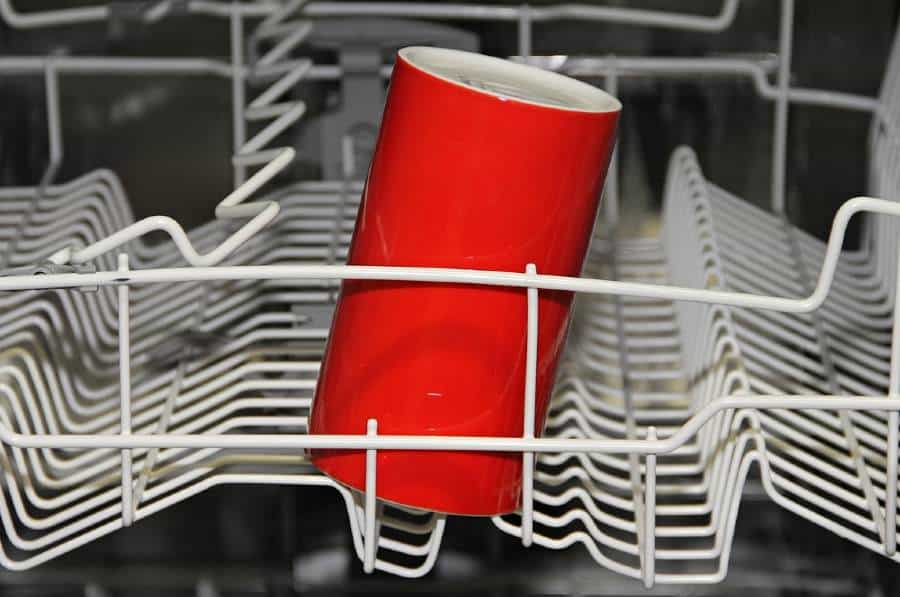
You have probably seen that most of the removable parts of your coffee maker are rated dishwasher safe top-rack only. For example, reusable filter baskets, hoppers, drip trays, and charcoal filter holders for single-serve and drip coffee makers such as Keurigs and Cuisinarts.
What does dishwasher safe top rack only mean?
Dishwasher safe top rack only means that the dishes should go in the upper rack of the dishwasher to avoid damage. In most dishwashers, the bottom rack is much hotter than the top rack because the heating element is below the bottom rack. The heat can warp or melt plastic dishes if they are washed at the bottom rack.
Since the heating element in most dishwashers is at the bottom. The bottom rack is the hottest part of dishwasher and should be used to clean serving bowls, plates, pans, and pots. The dirty side of these dishes should face the water jets.
Washing dishwasher-safe plastics too close to the heating element can cause warping or even melting if the plastic falls on the heating element.
Mechanical dishwashers spray hot water at 110-170°F on the dishes to remove the dirt and oils as well as disinfect the dishes.
During the drying cycle, the heating element at the bottom heats air to and the machine blasts the air through the dishes to evaporate the water. The temperature in the dishwasher is higher on the lower rack than on the top rack.
What is Overnight Setting on a Dishwasher?
The overnight setting on a dishwasher initiates a slow but thorough clean cycle that runs for up to seven hours. The dishwasher soaks the dishes longer than usual before cleaning them.
You may want to use the overnight setting to clean heavily soiled dishes.
Although the overnight setting is ideal to run at night due to the long hours, the dishwasher may be too loud and disrupt your sleep.
Why Plastic Does not Dry in Dishwasher
There are two reasons as to why plastic does not dry in the dishwasher:
- Plastics have a lower thermal mass. Plastic is lighter than materials such as ceramics and glass and loses heat much faster than these materials. If you open your dishwasher a few minutes after a wash cycle, the ceramic ware and glassware will be hotter than the plastics. During drying, plastics cool faster hence the water on the plastic surface does not evaporate. The steam in the dishwasher may also condense on the cooler plastics whereas the water on the surface of the ceramics and glassware evaporates as they remain hotter longer
- Plastic repels water. Most plastics repel water molecules leading to the molecules beading up into droplets that are hard to evaporate. On the other hand, water adheres to glass, and water molecules spread out on the glass surface forming a thin layer that evaporates fast.
Some newer dishwashers have a dish-drying boost feature in some brands or an extended dry function in others that improves the drying process including on plastics.
How Long Can Dishes Stay in the Dishwasher After Cleaning?
You can probably get away with leaving dishes in the dishwasher for a few hours or overnight after a cleaning cycle but you may want to avoid leaving them in there over an extended period as you risk bacteria growing on the clean dishes.
Although dishwashers sanitize dishes during cleaning, the bottom of the dishwasher does not dry out completely and some bacteria can start growing over time. The inner walls of the dishwasher are likely to be grimy and can impart a bad odor on the dishes.
You may want to run a rinse-only cycle for clean dishes that have been in the dishwasher for too long to freshen and disinfect them.
How Long Can You Leave Dirty Dishes in the Dishwasher?
On average, most small families and individuals living alone continuously load the dishwasher over several days until it’s fully loaded for a cleaning cycle.
You are better off running a daily rinse cycle when loading the dishwasher over several days to keep insects (ants, bugs, and roaches) and bad odors away. The rinse cycle uses very little water with no detergent for 10-15 minutes.
Keep the dishwasher door closed throughout the loading days when you have dirty dishes in there. Although some bacteria may grow during the prolonged loading period, dishwashers use high-temperature water to kill most of the bacteria.
In fact, activating the sanitize setting raises the wash temperature to at least 150°F and increases the wash time to destroy 99.99 percent of the bacteria. Running the dishwasher on full load not only saves time but also water and energy.
Should You Open a Dishwasher Immediately after Cycle?
Yes, you should open the door of a dishwasher that does not have a heated drying feature after a cycle to release the steam and speed up drying. You may want to avoid opening the door too wide to prevent scalding from the hot steam and water.
Some dishwashers automatically open the door by a few inches when the cycle is done. However, it is not necessary to open a dishwasher that has a heated drying function unless you are not using this feature.
The heat dry feature circulates hot air around the dishes to evaporate the water and accelerate drying.
Some dishwashers also have an extended drying feature that either prolongs the heat dry duration or increases the rinse temperature for better drying.
Dishwasher vs Handwash: Which One is Cheaper?
A dishwasher saves time, energy, and water as compared to handwashing. A new Energy Star certified dishwasher can save up to more than 230 man-hours, over 7,000 gallons of water, and about $110 in utility bills per year.
The dishwasher also cleans and disinfects the dishes much better than handwashing. Energy Star-certified dishwashers are about 12 percent more efficient than non-certified machines.
When aggregated for American homes with dishwashers, the savings are quite significant considering that as of 2015, at least eight million American homes used a dishwasher at least once per week. That’s about 54 percent of the 16 million American homes that had a dishwasher.
This number must have increased over the years. Statistical forecasting suggests that about 8.69 million dishwashers were shipped in the United States in 2019 as compared to 7.33 million units in 2015.
The increased national saving on energy and water contributes to a greener environment and the aggregate saving on utility bills and man-hours can considerably impact national consumption and productivity respectively.
Are New Dishwashers Better than Old Ones?
Technological advancements in new dishwashers provide several benefits over the old dishwashers:
- Less noise. Some new dishwashers use filters, unlike the old dishwashers that featured noisy grinders to break down food particles. The filters need frequent cleaning to prevent clogging. Other noise-reducing features in modern dishwashers include insulated doors
- Energy-efficient. New dishwashers use less electricity and water than old models and positively impact the environment
- New features. New premium dishwashers provide more usable space and loading options using features such as foldable tines and adjustable racks. Some models also feature a third rack that sits above the upper rack and holds cutlery and flatware
- Independent wash cycles and zone jets. Some new dishwashers have an independent top rack wash cycle function for cleaning dishes that are on the top rack. This saves energy and time when washing less than a full load. Zone jets clean the dishes in a particular area of the dishwasher such as the cutlery basket and bottle washing for thorough results than older dishwashers
The Solution for a Top Rack Safe Item not Fitting in the Dishwasher
If a top rack safe item is not fitting in the dishwasher, adjust the size of the top rack and fold the tines on the top rack to create some more room. However, if the top rack safe item is still taller or wider than the available space, hand wash it in warm soapy water.
Final Thoughts
Top rack dishwasher safe dishes should only be washed in the top shelf of the dishwasher as they are likely to warp or get damaged if they are washed in the much hotter bottom rack.
